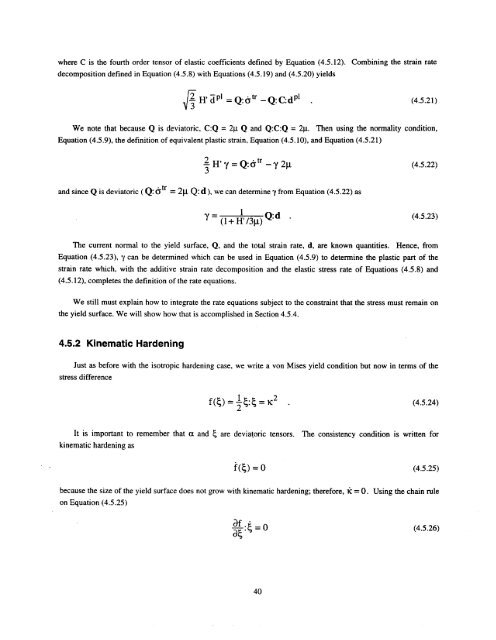II II II II II I - Waste Isolation Pilot Plant - U.S. Department of Energy
II II II II II I - Waste Isolation Pilot Plant - U.S. Department of Energy
II II II II II I - Waste Isolation Pilot Plant - U.S. Department of Energy
- No tags were found...
Create successful ePaper yourself
Turn your PDF publications into a flip-book with our unique Google optimized e-Paper software.
where C is the fourth order tensor <strong>of</strong> elastic coefficients defhwd by Equation (4.5.12). Combining the strain rate<br />
decomposition defined in Equation (4.5.8) with Equations (4.5.19) and (4.5.20) yields<br />
(4.5.21)<br />
We note that because Q is deviatoric, C:Q = 2P Q and Q:C:Q = 21.L. Then using the normality condition,<br />
Equation (4.5.9), the definition <strong>of</strong> equivalent plastic strain, Equation (4.5.10), and Equation (4.5.21)<br />
2HIy=Q:6tr–<br />
3<br />
Y2Y<br />
(4.5.22)<br />
and since Q is deviatoric ( ~ btr = 2V Q: d ), we can determine y from Equation (4.5.22) as<br />
y = (1+14’/3~)<br />
Qd . (4.5.23)<br />
The current normal to the yield surface, Q, and the total strain rate, d, are known quantities. Hence, from<br />
Equation (4.5.23), ~ can be determined which can be used in Equation (4.5.9) to determine the plastic part <strong>of</strong> the<br />
strain rate which, with the additive strain rate decomposition and the elastic stress rate <strong>of</strong> Equations (4.5.8) and<br />
(4.5. 12), completes the definition <strong>of</strong> the rate equations.<br />
We still must explain how to integrate the rate equations subject to the constraint that the stress must remain on<br />
the yield surface. We will show how that is accomplished in Section 4.5.4.<br />
4.5.2 Kinematic Hardening<br />
Just as before with the isotropic hardening case, we write a von Mises yield condition but now in terms <strong>of</strong> the<br />
stress difference<br />
f(~) =+&~=K2 . (4.5.24)<br />
It is important to remember that a and ~ are deviatoric tensors. The consistency condition is written for<br />
kinematic hardening as<br />
f(g) = o (4.5.25)<br />
because the size <strong>of</strong> the yield surface does not grow with kinematic hardening; therefore, k = O. Using the chain rule<br />
on Equation (4.5.25)<br />
(4.5.26)<br />
40
















